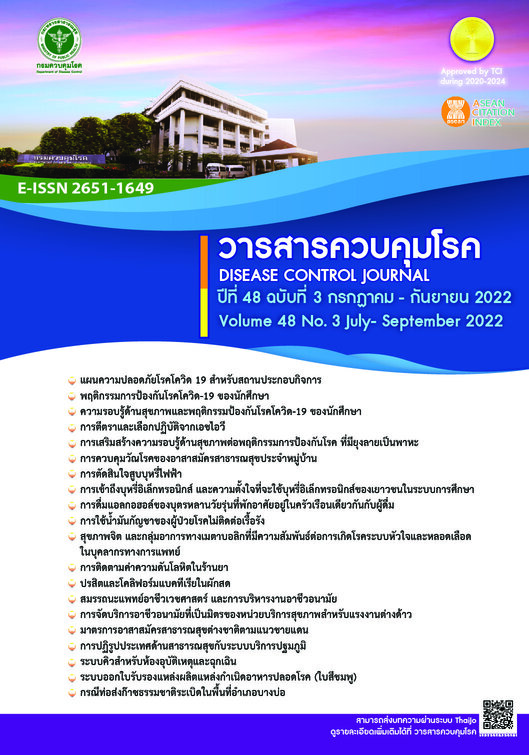Development of an Occupational Friendly Health Service Model for Migrant Workers Using Modified Delphi Techniques
DOI:
https://doi.org/10.14456/dcj.2022.54Keywords:
Friendly occupational health services, Migrant worker, Modified Delphi techniqueAbstract
This study was aimed to develop a friendly-migrant occupational health services (OHS) model among health care units for migrant workers. The descriptive study was conducted during year 2019 - 2020 and it consisted of two stages including the situation analysis, formation and model development. In stage I, the qualitative data were collected from executive staff and related officers at 2 hospitals in Samut Sakhon and Samut Prakan using in-depth interview and focus group methods. The thematic analysis was used to analyze such data. In stage II, modified Delphi technique was used to develop the model. Two rounds of questionnaires were sent out to the experts who worked in occupational health issue. The quantitative data were analyzed using frequency, percentage, median and interquartile range (IQR). Results in stage I showed that Samut Sakhon hospital could provide both passive and pro-active OHS to migrant employees. The interpreters have been employed to facilitate during services provision at the migrant clinic. Only in-house OHS have been provided for migrant workers in Samut Prakan hospital and Interpreters offered by non-governmental organization were available only in Tuberculosis clinic. Results of the 2nd round of questionnaire in stage 2 showed that the median and IQR were 5 or 6, and 0 – 1, respectively. Such data indicated that 21 experts agreed to all proposed statements. The OHS model displayed that some activities such as pre-placement health examination, periodic health examination, occupational diseases screening, diagnosis and record, return to work management and occupational health (OH) risk communication should cover migrant workers as well. In addition, the health service units should train related staff, employ Interpreters, and provide 2-3 languages OH and safety media following the friendly services concept. The limitations of this study revealed as follow; 1) based on time constraint, this model was not evaluated in the field and 2) such model was developed based on the context of formal migrant workers. This study recommended that the model should be launched to health services units which are located in the abundant migrant provinces to increase the accessibility of OHS among migrant workers.
Downloads
References
International Labour Organization. Relevant SDG Targets related to Labour Migration [Internet]. 2018 [cited 2018 Dec 25]. Available from: https://www.ilo.org/global/topics/ dw4sd/themes/migration/WCMS_558577/lang--en/index.htm
International Labour Organization. Convention C161 - Occupational Health Services Convention, 1985 (No. 161) [Internet]. 1985 [cited 2019 Jan 15]. Available from: https:// www.ilo.org/dyn/normlex/en/
Department of Disease Control (TH), Center of Occupational and Environmental Health Service Development and Accreditation. Occupational health service standard results among provincial hospitals in Thailand. Handout of the Occupational Health Services Accreditation results among Participated Hospital Virtual Meeting; 2021. (in Thai)
Siriruttanapruk S. Occupational health and safety problems among migrant workers. Handout of the Occupational Health and Safety for Migrant workers Meeting; 2017. (in Thai)
Mahasakpan P. Occupational health services for migrant workers in Mae Sot Hospital. Handout of the Occupational Health and Safety for Migrant workers Meeting; 2017. (in Thai)
World Health Organization. Monitoring the building blocks of health systems: a handbook of indicators and their measurement strategies [Internet]. 2010 [cited 2018 Feb 22]. Available from: https://www.who.int/healthinfo/systems/WHO_MBHSS_2010_full_web.pdf
Office of Health Region 1 (TH), Service Plan Committee Health Region 1. Service plan development. Chiangmai: Office of Health Region 1; 2014. (in Thai)
Country Office for Thailand, World Health Organization. From burden to challenges: decade of learning and development, Review of Client-Friendly Health Services for Cross-border Migrant in Thailand (2004-2014) [Internet]. 2014 [cited 2018 Apr 14]. Available from: https://apps.who.int/iris/handle/10665/204611
Jensantikul N. Utilizing the Delphi Technique for research. KUPSR J. 2017;4(2):47–64. (in Thai)
Rathachatranon W. Future Research Using Delphi Technique. JIRGS. 2019;8(1):1–10. (in Thai)
Department of Disease Control (TH), Occupational and Environmental Health Development Center, Samut Prakan. Occupational health services standard for central/general hospital [Internet]. 2018 [cited 2019 Apr 18]; Available from: http://envocc.ddc.moph.go.th/uploads/samutprakarn/2562/3.guide20central62_1dec61.pdf (in Thai)
Bangkok Metropolitan Administration (TH). Office of Town Planning. Effect from public health services delivery for migrant workers among hospitals under Bangkok Metropolitan Administration. Bangkok: Office of Town Planning; 2017. (in Thai)
Kosiyaporn H, Julchoo S, Phaiyarom M, Sinam P, Kunpeuk W, Pudpong N, et al. Strengthening the migrant-friendliness of Thai health services through interpretation and cultural mediation: a system analysis. Glob Health Res Policy. 2020;5(53):1-13.
Migrant-friendly hospital: A literature review [Internet]. [cited 2021 Nov 6]. Available from: https://www.theseus.fi/handle/10024/21643
Fabienne NJ, Ligia K, Mazeda H, Cathy Z. Migrant-friendly hospitals: a pediatric perspective - improving hospital care for migrant children [Internet]. 2013 [cited 2021 Nov 6]. Available from: http://www.biomedcentral.com/1472-6963/13/389
Downloads
Published
How to Cite
Issue
Section
License
Copyright (c) 2022 Disease Control Journal

This work is licensed under a Creative Commons Attribution-NonCommercial-NoDerivatives 4.0 International License.
Articles published in the Disease Control Journal are considered as academic work, research or analysis of the personal opinion of the authors, not the opinion of the Thailand Department of Disease Control or editorial team. The authors must be responsible for their articles.






